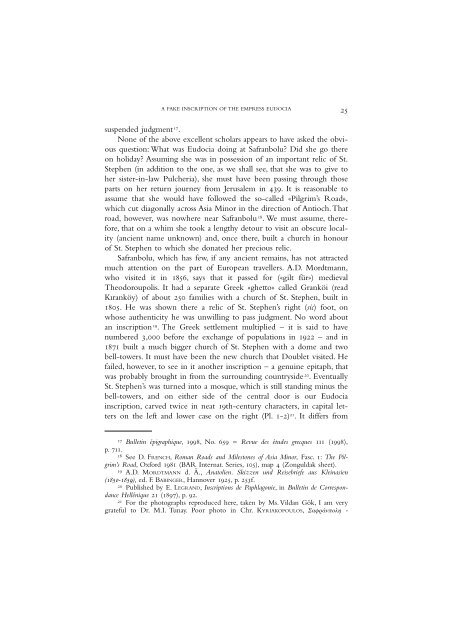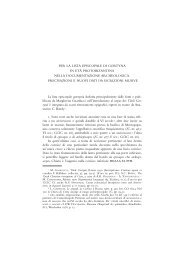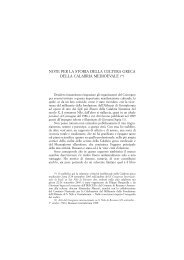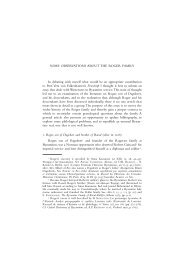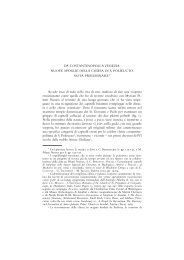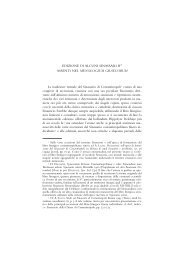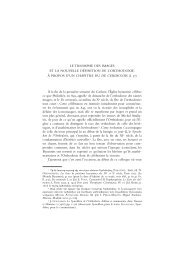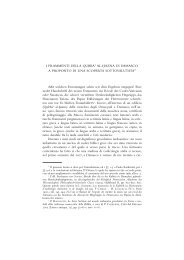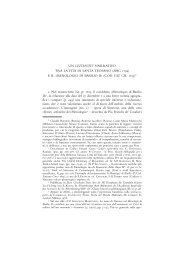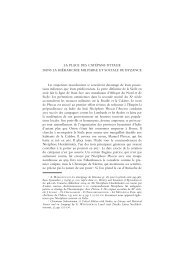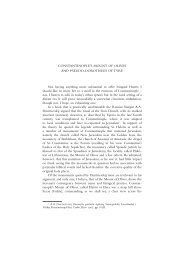Cyril Mango
Cyril Mango
Cyril Mango
Create successful ePaper yourself
Turn your PDF publications into a flip-book with our unique Google optimized e-Paper software.
A FAKE INSCRIPTION OF THE EMPRESS EUDOCIA 25<br />
suspended judgment 17 .<br />
None of the above excellent scholars appears to have asked the obvious<br />
question: What was Eudocia doing at Safranbolu? Did she go there<br />
on holiday? Assuming she was in possession of an important relic of St.<br />
Stephen (in addition to the one, as we shall see, that she was to give to<br />
her sister-in-law Pulcheria), she must have been passing through those<br />
parts on her return journey from Jerusalem in 439. It is reasonable to<br />
assume that she would have followed the so-called «Pilgrim’s Road»,<br />
which cut diagonally across Asia Minor in the direction of Antioch.That<br />
road, however, was nowhere near Safranbolu 18 . We must assume, therefore,<br />
that on a whim she took a lengthy detour to visit an obscure locality<br />
(ancient name unknown) and, once there, built a church in honour<br />
of St. Stephen to which she donated her precious relic.<br />
Safranbolu, which has few, if any ancient remains, has not attracted<br />
much attention on the part of European travellers. A.D. Mordtmann,<br />
who visited it in 1856, says that it passed for («gilt für») medieval<br />
Theodoroupolis. It had a separate Greek «ghetto» called Granköi (read<br />
Kıranköy) of about 250 families with a church of St. Stephen, built in<br />
1805. He was shown there a relic of St. Stephen’s right (sic) foot, on<br />
whose authenticity he was unwilling to pass judgment. No word about<br />
an inscription 19 . The Greek settlement multiplied – it is said to have<br />
numbered 3,000 before the exchange of populations in 1922 – and in<br />
1871 built a much bigger church of St. Stephen with a dome and two<br />
bell-towers. It must have been the new church that Doublet visited. He<br />
failed, however, to see in it another inscription – a genuine epitaph, that<br />
was probably brought in from the surrounding countryside 20 . Eventually<br />
St. Stephen’s was turned into a mosque, which is still standing minus the<br />
bell-towers, and on either side of the central door is our Eudocia<br />
inscription, carved twice in neat 19th-century characters, in capital letters<br />
on the left and lower case on the right (Pl. 1-2) 21 . It differs from<br />
17 Bulletin épigraphique, 1998, No.659 = Revue des études grecques 111 (1998),<br />
p. 711.<br />
18 See D. FRENCH, Roman Roads and Milestones of Asia Minor, Fasc. 1: The Pilgrim’s<br />
Road, Oxford 1981 (BAR Internat. Series, 105), map 4 (Zonguldak sheet).<br />
19 A.D. MORDTMANN d. Ä., Anatolien. Skizzen und Reisebriefe aus Kleinasien<br />
(1850-1859), ed. F. BABINGER, Hannover 1925, p.253f.<br />
20 Published by E. LEGRAND, Inscriptions de Paphlagonie, in Bulletin de Correspondance<br />
Hellénique 21 (1897), p. 92.<br />
21 For the photographs reproduced here, taken by Ms. Vildan Gök, I am very<br />
grateful to Dr. M.I. Tunay. Poor photo in Chr. KYRIAKOPOULOS, Σαφράνπλη -


